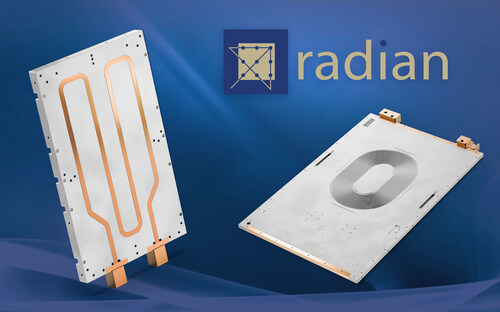Radian Thermal Inc. further develops Liquid Cold Plate technology with a focus on innovation and best practices.
SANTA CLARA, Calif., Oct. 17, 2025 /PRNewswire-PRWeb/ -- As electronics and digital systems grow more compact with higher thermal densities, thermal management has become a defining engineering challenge. Radian Thermal Products Inc., a global manufacturer of cooling devices, furthered its commitment to incorporating liquid cold plates in enabling reliable, high-power-density cooling across industries from automotive to aerospace.
With this in mind, Radian highlights its line of skived micro-fin cold plates for increased heat transfer, machined channel cold plates for use with thermal electric coolers, along with standard cold plates with multi-loop pipe arrangements.
"Power densities are increasing faster than ever, especially with the rise of AI and its effects on datacentres and telecom networks," said Thierry Sin, CEO of Radian Thermal Products Inc. "Liquid cold plates and liquid cooling solutions have an increasingly important role in maintaining efficiency, reliability, and system longevity."
Liquid Cold Plates: The Backbone of High-Performance Cooling
Liquid cold plates are precision-engineered heat exchangers that transfer heat away from critical components through internal channels carrying coolant. This design maximizes thermal contact and provides a highly efficient method of heat removal compared to traditional air-cooled systems.
Common configurations include machined, bonded, and brazed cold plates, each selected based on application-specific needs. Materials such as aluminum and copper are most frequently used—aluminum for its lightweight and cost efficiency, copper for its superior conductivity and thermal performance.
As Radian's engineering team explains, Liquid Cold Plate technology is well suited to the following industrial sectors:
- Electric vehicles, where liquid cooling supports optimal battery temperature and system safety.
- Aerospace and defense systems, which require lightweight, high-reliability thermal components.
- Telecommunications and data infrastructure, where dense electronics generate concentrated heat flux.
- Renewable energy applications, such as inverters and converters, where efficient heat management improves uptime and efficiency.
Engineering Considerations and Design Trends
The performance of a liquid cold plate depends heavily on its internal channel geometry, coolant selection, and manufacturing method. Engineers must balance thermal resistance, pressure drop, and weight to ensure consistent cooling under variable loads.
Friction Stir Welding (FSW) and Diffusion Bonding have emerged as preferred fabrication techniques for modern cold plates, allowing for fine-tuned designs that achieve superior mechanical integrity and thermal conductivity without introducing filler materials.
In addition, microchannel designs and additive manufacturing are opening new frontiers in cold plate performance. These innovations enable smaller channel diameters and complex flow paths that enhance heat transfer efficiency. Meanwhile, smart monitoring sensors integrated into cooling systems now allow engineers to track temperature, flow rate, and pressure in real time—improving predictive maintenance and system optimization.
"Today's cooling solutions need to be adaptive," added Mr. Sin. "As heat dissipation becomes harder to manage, thermal management systems should become more innovative. Combining liquid cooling with air cooling and 2-phase cooling gives engineers new ways to solve complex thermal dissipation problems."
Market Context and Future Outlook
The global demand for liquid cooling technologies is rising rapidly, driven by electrification, miniaturization, and sustainability goals. Electric vehicles, 5G infrastructure, and renewable energy systems are among the fastest-growing sectors adopting liquid cold plate cooling to achieve both performance and energy efficiency.
Liquid cold plates provide the consistency needed to ensure mission-critical electronics remain within operational limits even in harsh environments.
Radian's research indicates that combining liquid cold plate cooling with hybrid air-liquid systems may further expand the performance envelope, offering modular solutions that scale with power density requirements. These advancements underscore the increasing importance of collaborative design between thermal engineers, materials scientists, and system architects.
Radian's Liquid Cold Plate Solutions
Radian designs and manufactures custom liquid cold plates using advanced methods including FSW, brazing, and copper tube embedding. Each design is optimized for thermal efficiency, pressure drop, and manufacturability—tailored to meet the unique requirements of high-power applications.
Founded in 1974, Radian Thermal Products Inc. has grown into a global provider of thermal management solutions with manufacturing operations in the United States, Taiwan, China, and Vietnam. The company's 50-year legacy reflects its continued commitment to innovation and reliability in cooling technologies that drive modern electronics.
About Radian Thermal Products Inc.
Radian specializes in advanced thermal management solutions for industries including automotive, aerospace, telecommunications, renewable energy, and computing. With expertise spanning custom heat sinks, liquid cooling systems, and precision thermal design, Radian combines global manufacturing with deep engineering expertise to deliver reliable, high-performance cooling products.
Learn more about the company by visiting its website.
Media Contact
Danny Hin, Radian Thermal Products Inc., 1 408-988-6200 105, [email protected], https://radianheatsinks.com/
SOURCE Radian Thermal Products Inc.



Share this article